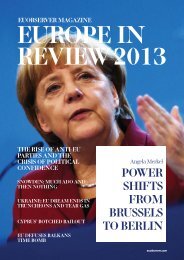EU Elections
EUobserver's guide to the 2024 European Parliament Elections.
EUobserver's guide to the 2024 European Parliament Elections.
- No tags were found...
You also want an ePaper? Increase the reach of your titles
YUMPU automatically turns print PDFs into web optimized ePapers that Google loves.
<strong>EU</strong>ROPEAN ELECTIONS<br />
60%<br />
50%<br />
40%<br />
30%<br />
Turnout by accession date, European Parliament elections<br />
2014 & 2019<br />
The same high turnout factors apply in<br />
Luxembourg. Interest and knowledge<br />
in European institutions is high, voting<br />
is compulsory and, until the 2014 elections,<br />
European Parliament elections<br />
took place on the same day as those for<br />
the national parliament. However, Luxembourg’s<br />
statistics look rather less impressive<br />
because of the 38 percent of the<br />
Grand Duchy’s residents who are citizens<br />
of other <strong>EU</strong> states than Luxembourg,<br />
only around 10 percent of those are on<br />
the electoral register – participation of<br />
the eligible population is therefore in the<br />
mid-60 per cent range rather than the<br />
officially recorded 85 percent average for<br />
2014 and 2019.<br />
20%<br />
10%<br />
0%<br />
2014<br />
Pre-2004 <strong>EU</strong> 15<br />
Source: European Parliament in collaboration with Kantar<br />
Post 2004 accessions<br />
2019<br />
Election after election,<br />
Belgium has been the<br />
champion member state<br />
for participation, with an<br />
average turnout of 90.6<br />
percent since 1979.<br />
The highest turnout without compulsory<br />
voting is in Malta, where party allegiances<br />
are very strong among the electorate.<br />
After Malta comes Italy and Greece, both<br />
of which have seen large decreases in<br />
European Parliament turnout since the<br />
turn of the century; both countries have<br />
abandoned a ‘soft’ form of compulsory<br />
voting based on minor discrimination<br />
against non-voters in providing civic<br />
services – Italy in 1993, Greece in 2000.<br />
Turnout in the 2022 Italian parliamentary<br />
election was well down on any previous<br />
election (64 percent, compared to<br />
73 percent in 2018 and over 80 percent<br />
before 2013) so it may have further to fall<br />
for the European Parliament in 2024.<br />
The biggest rise in turnout in 2019 was<br />
in Poland. Participation nearly doubled,<br />
from 24 percent to 46 percent, reflecting<br />
the increased political polarisation that<br />
has also raised turnout in national parliamentary<br />
elections – from 51 percent in<br />
2015 to 62 percent in 2019 and 74 percent<br />
in 2023.<br />
The worst?<br />
The worst turnouts in EP elections have<br />
consistently been in Slovakia, Croatia,<br />
the Czech Republic and Slovenia; the<br />
turnout in Slovakia rose above 20 percent<br />
for the first time in 2019 but it is, as it has<br />
57

















